|
|
GAINING PSYCHOLOGICAL ADVANTAGE
|
|
Whether or not they understand the details, virtually all successful trainers of difficult
horses have a few things in common. They establish their leadership position, gain the horse's confidence, and set up some kind of training regimen where the horse ultimately has to mentally process the situation and deal with it other than through flight.
Some horses basically don't want to respond through flight and as soon as they recognize that it's less physical work to interact with the trainer and deal with a particular situation, they take the easy road and work with their brains instead of their legs. These horses make the trainer look like Einstein, however all the trainer really did was create a doorway where the horse could see and recognize a better deal and let the horse's natural tendencies do the rest.
Some younger, naturally flighty and abused horses may not be comfortable thinking and interacting. For them to do this is as uncomfortable as a right handed person writing a lengthy essay with his/her left hand. Until the horse is conditioned to think, the thinking process itself can generate stress. At some point the stress will build up until the horse has to leave or "blows up." So how do we design the training environment so that we get beyond these obstacles? The following are concepts and approaches that we find are useful.
|
|
- Accept the horse's stress response.
We have to accept that training is going to generate stress and that
at some point the horse will reach a point he has to relieve it. This
doesn't mean we will accept the horse always responding unfavorably to stress,
but we don't let it upset us and we work methodically to bring it under control.
- Direct the stress response.
We need the horse to mentally stay in the training process. Thus when the horse
reaches his stress threshold, he may distance himself physically or mentally from a
specific stimulus but not stop interacting with his trainer. There are many ways
in which to accomplish this objective, one being to encourage the horse to always come
right back to the trainer who becomes his "safety net."
- Shorten the stress response
A horse's natural programming is to flee from something fearful for about a quarter
mile, then turn around and investigate it from a distance. The trainer can shorten
this stress response little by little until the horse basically "spooks in place"
and activates his curious, investigative apparatus without leaving. An example of how
to accomplish this would be to have the horse on a line in the round pen. When he has
to leave, the trainer turns the horse back in toward his personal "safety net,"
shortening the flight distance a little each time until the horse stays pretty close
by and invests more energy reading the trainer's actions than in responding to Mother
Nature's screaming, "Run for your life!" into his right brain.
- Develop learn-learn responses
With a particularly difficult horse we put his flight response to work. In other
words, we don't let the horse engage in mindless flight but we direct the horse to do
something useful. By doing so we keep the horse's left brain active and he will
eventually equate his flight drive with work.
- Develop stress substitutes
Horses generate less stress when their attention is captured in some positive way or
they are engaged in some conditioned behavior. A particularly spooky horse may
remain rational through the simple act of stroking his face or scratching his withers.
Clicker training is very useful tool for developing simple behavioral response
conditions that can be used to direct the horse's attention and keep his reasoning
process engaged during stressful endeavors.
Another important component involves the trainer's awareness that the horse is
generating stress and before the horse experiences a stress blowup, intentionally
directing the horse out on the line or into some other activity for a few moments
until the horse gets his head together.
- Accept that stress releases are still probable
While our objective is to eliminate mindless blowups in response to stress, we have
to realize that these events will continue to take place. In some instances the
horse may have learned to think through problems exceptionally well, but for a while
such mental stimulation will also stimulate his stress center and may cause a stress
response for no obvious reason. However as soon as the horse has emptied his
"stress tank," he should be ready to reenter the training process with a clear head.
|
This formally abused mare would have blind
"panic attacks" when approached with a bridle.
She needs occasional "time outs."
Sharon lets her work things out
then resumes the training process.
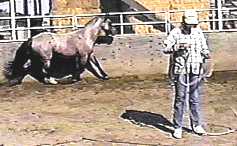
By managing the mare's stress
she comes back to deal with the "problem"
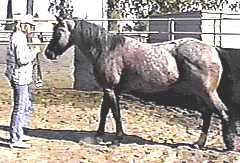
By not letting the horse completely
avoid the problem, but letting her
safely discharge her stress, she can
think things through and learn.
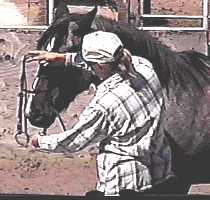
With her thinking apparatus working
she now processes the scary bridle in a
new way and the panic is gone.
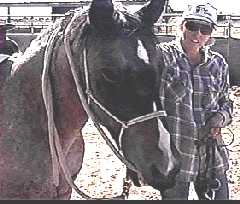
A "new" horse.
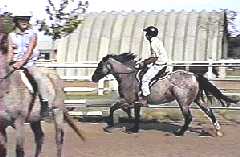
|
|
By considering the horse's stress apparatus, the observant trainer can work in ways that helps the horse reduce stress buildup, more easily relieve stress during the training process, and react in a less volatile manner when the horse reaches stress threshold.
|
Press "Back" to return to the page that brought you here
KBR Horse Training Information, © 1997
Lamm's Kickin' Back Ranch and Willis & Sharon Lamm. All rights reserved. Duplication of any of
this material for commercial use is prohibited without express written permission.
This prohibition is not intended to extend to personal non-commercial use, including sharing
with others for safety and learning purposes, provided this copyright notice is
attached.
Email us to submit comments or
request reproduction permission.
|